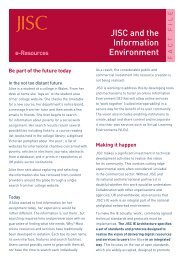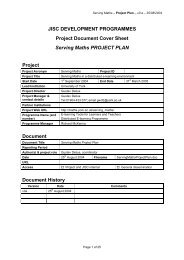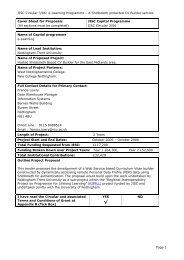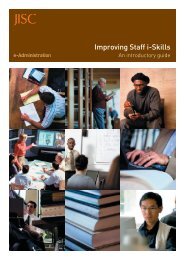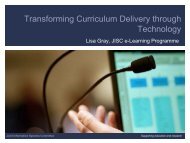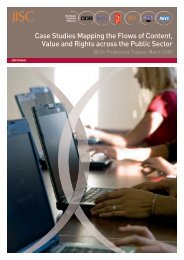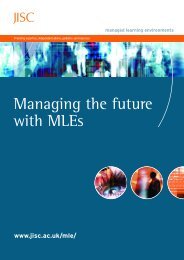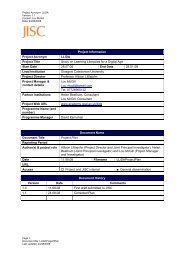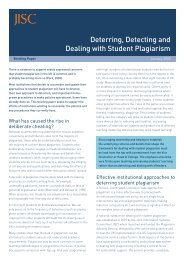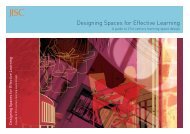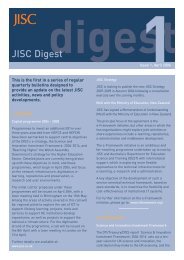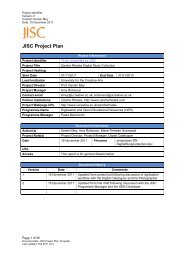Review of Advanced e-Assessment Techniques (RAeAT) Final ... - Jisc
Review of Advanced e-Assessment Techniques (RAeAT) Final ... - Jisc
Review of Advanced e-Assessment Techniques (RAeAT) Final ... - Jisc
Create successful ePaper yourself
Turn your PDF publications into a flip-book with our unique Google optimized e-Paper software.
Expert judgement/support systems<br />
An application that uses a knowledge base <strong>of</strong> human expertise<br />
and algorithms to emulate decisions that would be made by a<br />
human<br />
Extended text<br />
The use <strong>of</strong> technology to support input and/or scoring <strong>of</strong> prose<br />
responses in excess <strong>of</strong> 20 words or so.<br />
Feedback<br />
The provision <strong>of</strong> information and analyses for tutors, teachers<br />
and students based on individuals’ and groups’ performance on<br />
tests and assessments<br />
Formative<br />
The provision <strong>of</strong> information and analyses for students where the<br />
primary purpose <strong>of</strong> this is to inform decisions about next steps in<br />
learning<br />
Fuzzy logic/pattern matching<br />
The use <strong>of</strong> string matching computer techniques to compare<br />
students’ test responses to predicted and expected answers<br />
Group work<br />
The use <strong>of</strong> technology to set students group assessments, and<br />
to use technology to collect information about the performance <strong>of</strong><br />
the group and, sometimes, to score individual’s contributions to<br />
the overall group performance<br />
Higher order skills<br />
The use <strong>of</strong> technology to assess students higher order skills,<br />
including process skills (e.g. problem solving) and behavioural<br />
attributes (e.g. persistence and logic)<br />
Interactive skills<br />
The use <strong>of</strong> technology to assess student’s ICT skills<br />
Knowledge<br />
<strong>Assessment</strong> <strong>of</strong> domain knowledge, potentially using a variety <strong>of</strong><br />
item types<br />
Marking combining human/computer<br />
The use <strong>of</strong> technology to filter responses which can be<br />
automatically marked, presenting to human markers<br />
all responses that were not predicted or that cannot be<br />
automatically scored for other reasons<br />
Mobile phones<br />
The use <strong>of</strong> mobile phones to present assessment tasks and/or to<br />
collect student responses using the phone as an input device<br />
could be used as a vehicle for presenting a range <strong>of</strong> types <strong>of</strong><br />
assessment, including those which are designed to assess<br />
performance in using virtual world functionality and interactivity<br />
New approaches to student performance<br />
The use <strong>of</strong> technology to design and present measurements <strong>of</strong><br />
student performance not undertaken in paper-based or more<br />
traditional assessment. These innovations could be relatively<br />
technically and psychometrically straightforward (eg using video<br />
to present assessment stimulus material) or significantly more<br />
sophisticated (use <strong>of</strong> technology to assess group work, for<br />
example)<br />
PDAs<br />
The use <strong>of</strong> PDAs to present assessment tasks and/or to collect<br />
student responses using the PDA as an input device. In some<br />
instances, the PDA might be used as the tutor’s assessment<br />
handbook, reminding the tutor <strong>of</strong> the assessment rubrics and<br />
requirements<br />
Peer assessment<br />
The use <strong>of</strong> technology to collect peer-to-peer assessment<br />
judgements, possibly including the use <strong>of</strong> technology to present<br />
the assessment evidence<br />
Practical skills<br />
The use <strong>of</strong> technology to assess motor skills, physical skills,<br />
performance evidence and other types <strong>of</strong> practical skills<br />
Process<br />
The use <strong>of</strong> technology to collect evidence <strong>of</strong> student’s process<br />
performances, such as methods used to solve problems<br />
Psychometric theory<br />
The design <strong>of</strong> new and adaptive forms <strong>of</strong> performance<br />
measurement, leading to advances in psychometric theory not<br />
based on linear, item-based and paper-based forms <strong>of</strong> testing<br />
Short free text<br />
The use <strong>of</strong> technology to capture and score students’ short free<br />
text responses to test items.<br />
Speed<br />
The assessment <strong>of</strong> time-based aspects <strong>of</strong> students’<br />
performance, including the speed <strong>of</strong> their responses<br />
Training<br />
The use <strong>of</strong> technology to derive training-needs analysis, for<br />
instance by evaluating gaps and weaknesses in students’<br />
performance.<br />
Web2 – flickr, wikis<br />
The use <strong>of</strong> social technologies as a platform for presenting<br />
assessment tasks and/or capturing evidence <strong>of</strong> student<br />
performance<br />
VLEs<br />
The use <strong>of</strong> Virtual Learning Environments to launch assessments<br />
<strong>of</strong> any type<br />
Case study reports<br />
On reviewing the catalogue <strong>of</strong> e-assessment projects to<br />
select some to study in greater depth through case studies,<br />
it was agreed with JISC that two types <strong>of</strong> case study would<br />
be research. The first type would look broadly at a particular<br />
Case Study Report<br />
and its focus<br />
AsTTLE<br />
Adaptive testing<br />
<strong>Assessment</strong> 21<br />
Combining human/computer<br />
marking<br />
Primum<br />
Higher order skills<br />
Foreign language textual<br />
and spoken<br />
Short text<br />
e-assessment technique, reviewing a number <strong>of</strong> initiatives to<br />
provide analyses <strong>of</strong> issues underpinning that technique. These<br />
thematic case studies examined Short Text, Foreign Language<br />
Textual and Spoken and Storage/databanks. The remaining<br />
case study reports take as their focus the specific e-assessment<br />
project.<br />
The table below summarises the case studies, also providing<br />
information about the name <strong>of</strong> the institution, lead contact and<br />
research completed.<br />
These five case study reports have been published as separate<br />
and stand-alone documents. They are available at http://www.<br />
dur.ac.uk/smart.centre1/aeac In brief, the case study reports<br />
cover the following content.<br />
Institution(s)/company Contact Research completed<br />
University <strong>of</strong> Auckland John Hattie Telephone, email and deskbased<br />
research<br />
University <strong>of</strong> Manchester Dr Mary McGee Email and desk-based research<br />
and site visit on 2 March 2009<br />
National Board <strong>of</strong> MEdical<br />
Examiners (NBME)<br />
Philadelphia USA<br />
Brian Clauser<br />
Telephone, email and deskbased<br />
research<br />
LISC – University <strong>of</strong> Kent Alison Fowler Email and desk-based research<br />
and site visit on 2 March 2009<br />
Pearson Versant<br />
Automark, University <strong>of</strong><br />
Dundee<br />
Jared Bernstein and Alistair<br />
Van Moere<br />
Walter Williamson, John<br />
McEwen<br />
Telephone, email and deskbased<br />
research<br />
Email and desk-based research<br />
and site visit on 20 January<br />
2009<br />
MUVEs & Virtual Worlds<br />
The use <strong>of</strong> Multiple User Virtual Environments or other types<br />
<strong>of</strong> Virtual World to conduct assessments. The virtual worlds<br />
Voice/performance skills<br />
The use <strong>of</strong> technology to capture voice (i.e. spoken word)<br />
evidence <strong>of</strong> performance<br />
8<br />
9




